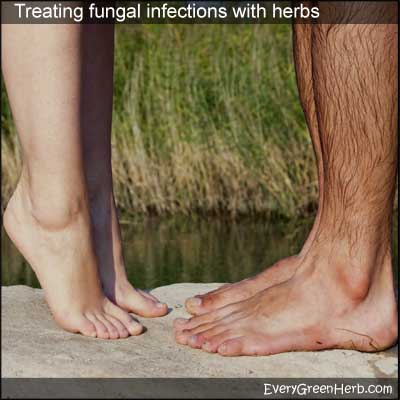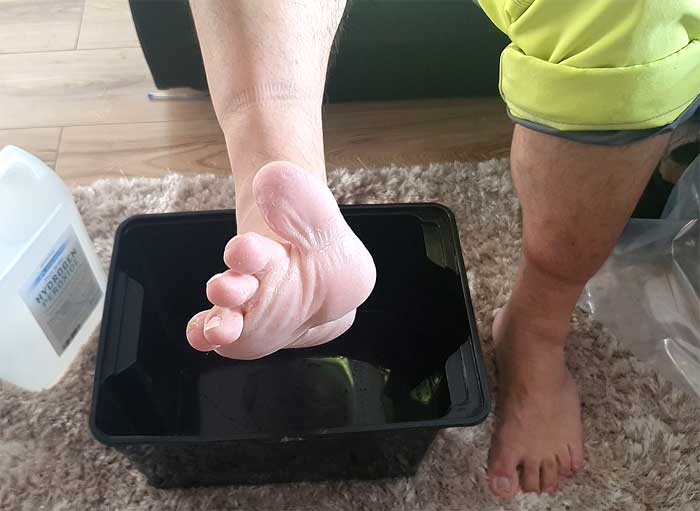Athlete's foot and fungus remedies
Athlete's foot, toenail problems, and ringworm infections are caused by fungus. I am glad to report that herbs and essential oils can help!

Fungi are plant like organisms that thrive in dampness and warmth. They can be passed from person to person or from one area to another.
Symptoms include moist, weepy, red patches of skin, scaling or peeling skin, thickened skin, irritated blotches with blisters, and unpleasant odor.
Herbs and essential oils can help!
Scientific studies on herbs and fungus
Controlled clinical trials show that herbal products such as tea tree oil and bergamot essential oil produce positive outcomes when treating fungal infections.
Dampness between the toes is a perfect breeding ground for fungus.
Tests show that applying a mix of arrowroot powder, baking soda, basil oil, bay oil tea tree oil, sage oil, and clove oil significantly lowered yeast-fungi counts. It works and it smells good, too.
Give this mix a try if you suffer from athlete's foot.

Tea tree essential oil fights toenail fungus.
Tea tree essential oil is an excellent remedy that fights fungus infection including tough under the toenail varieties. Before treatment, clean area and gently scrape away as much dead skin from around the nails as possible.
I use it undiluted, but if you have really sensitive skin, you can dilute the tea tree oil with a good carrier like olive oil.
Apply tea tree essential oil directly to infected nails at least once a day. Be sure to get underneath and around the nail bed. Successful treatment requires frequent applications over a period of time, so don't give up.
If you experience tenderness, or signs of allergic reaction, discontinue use and try diluted bergamot essential oil or another natural remedy.
If you have been reading my Every Green Herb blog for a while, then you know we grow and sell a variety of herbs, but we also buy a lot, too. Try our favorite herbal suppliers for quality and value.
Where can fungi grow?
Fungi can grow everywhere from the the scalp on top of the head to the tips of the toes. Athlete's foot is usually found on the feet. Ringworm may appear on the lets, arms, stomach, or chest.
Fungus can grow on other areas of the body that are moist including under the arms and in fleshy folds of the skin.
Yeast overgrowth is a type of fungus infection. Read about healing yeast infection and candidiasis with natural remedies if you think that might be the cause of your skin problems.
Garlic juice can kill fungus.
Garlic is anti-fungal and builds immunity. Apply garlic juice to infected area three or four times a day.
Also take garlic by mouth. We grow a lot of garlic for our personal use and eat it almost daily.
Garlic caps are available at health food stores and may be a better choice if bad breath is a concern. Since we live on a farm and don't work in an enclosed environment, we eat all the garlic we want without worry. It might be different if we worked in an office.
Treat athlete's foot with herbal foot bath.
Athlete's foot sufferers can benefit from a foot bath. Soak feet in a mixture of warm dandelion root tea, tea tree essential oil, and black walnut extract. Some herbalists call for a cup of vinegar to be added to this bath.
Soak for up to thirty minutes several times a day if possible. After your foot soak, follow with a generous application of witch hazel.

More herbal remedies to treat athlete's foot
Athlete's foot fungus loves moisture so try to keep feet dry and go barefooted whenever possible. Exposure to sunlight can also bring good results.
Sometimes dabbing vinegar between the toes can bring soothing relief. A garlic and honey poultice can work wonders if you have time to sit for an hour or two.
Treating ringworm with herbs
Ringworm calls for strong basil tea or myrrh extract applications. Other herbal remedies to try are grapefruit seed extract, yellowroot, oregano, evening primrose oil, aloe, and calendula cream.
For stubborn ringworm infection mix two teaspoons of sesame seed oil, two teaspoons of brewer's yeast, and a powdered B vitamin. Apply before bed and leave on all night. Rinse in the morning and follow with ten or fifteen minutes of sunshine. Repeat as necessary.
Treat fungus by building immunity with herbs like ginseng and astragalus.
Reoccurring and persistent fungus infections indicate a suppressed immune system. Ginseng, astragalus, Echinacea, licorice, shiitake mushrooms, calendula, chamomile, burdock, dandelion, kelp, thyme, lavender, lemon, red clover, marshmallow, garlic, or mullein should be taken in tea form or added to the diet on a daily basis.
Try chewing on a ginseng root, sipping chamomile tea, taking a teaspoon of licorice tincture, and adding thyme leaves to a salad. It will help improve immunity and fight fungus infections.
Read more about building immunity with herbs.
Exercise and massage can flush out toxins.
When taking herbs to build the immunity, remember that a healthy lymphatic system is very important. Since the lymph glands aren't pumps, they depend on body movement to get things going.
Exercise, massage, and alternating hot and cold baths can really boost the immune system. Once toxins are flushed from the body and healing properties from the herbal remedies are transported to cells, fungal infections don't stand a chance.
*Always consult with a healthcare professional before using any herbal remedy.
Sources:
https://pubmed.ncbi.nlm.nih.gov/15078424/
https://www.ncbi.nlm.nih.gov/pmc/articles/PMC1997117/
Blessings to you and yours!
Thanks so much for reading my blog. Jan.

*Note - the information on this website has not been evaluated by the Food and Drug Administration.
© 2005-2024 website design and content by Janice Boling